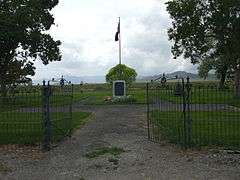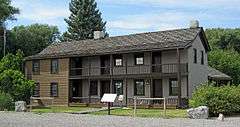Camp Floyd / Stagecoach Inn State Park and Museum
|
Camp Floyd Site | |
|
Camp Floyd Cemetery in Utah | |
 | |
| Nearest city | Fairfield, Utah |
|---|---|
| Coordinates | 40°15′26″N 112°6′14″W / 40.25722°N 112.10389°WCoordinates: 40°15′26″N 112°6′14″W / 40.25722°N 112.10389°W |
| Area | 40 acres (16.2 ha) |
| NRHP Reference # | |
|
Stagecoach Inn | |
|
| |
| Location |
18035 West 1540 North Fairfield, Utah |
| Coordinates | 40°15′41″N 112°5′34″W / 40.26139°N 112.09278°W |
| Area | 1.4 acres (0.6 ha) |
| NRHP Reference # | 71000857[1] |
| Added to NRHP | May 14, 1971 |
| Added to NRHP | November 11, 1974 |
Camp Floyd was a short-lived U.S. Army post in the Cedar Valley (and now part of Fairfield), Utah, United States. The Stagecoach Inn was a nearby hotel which also served as a stagecoach stop and, during 1860-1861, a Pony Express stop. Both were listed on the National Register of Historic Places in the 1970s, and now are included in a Utah state park known as Camp Floyd / Stagecoach Inn State Park and Museum.
Camp Floyd

Established in July 1858 by a U.S. Army detachment under the command of Brevet Brig. Gen. Albert Sidney Johnston, Camp Floyd was named for then Secretary of War John B. Floyd. The detachment consisted of more than 3,500 military and civilian employees, including cavalry, artillery, infantry and support units. This unit, the largest single troop concentration then in the United States, was sent by President James Buchanan to stop a perceived Mormon rebellion, which came to be known as the Utah War.
From Fort Leavenworth, Kansas, the army marched to Fort Bridger, Wyoming where it spent the winter of 1857. Troops arrived in Salt Lake City, Utah in June 1858. Soon after their arrival, troops settled in the Cedar Valley area and eventually Fairfield, where 400 buildings were constructed by November 1858. A series of photographs of Camp Floyd, taken by Samuel C. Mills in January 1859, show the post as a cluster of adobe buildings including barracks, officers quarters, warehouses and other sundry structures. Enough civilians soon followed to increase the town size to 7000, almost half that of Salt Lake City. The rebellion never took place, leaving the army with routine garrison duty that included protecting the stagecoach and Pony Express routes, preventing Indian marauding, and mapping and surveying responsibilities.
Supplying the large garrison, 1,100 miles (1,800 km) from Fort Leavenworth, was costly. It was rumored to be an attempt by Secretary of War Floyd (a known southern sympathizer) to drain the federal treasury. A contract with the firm of Russell, Majors and Waddell for delivery of 16 million pounds (7.3 kt) of freight required 3,500 wagons, 40,000 oxen, 1,000 mules and more than 4,000 men. This same company formed the Pony Express, which had a station in Fairfield.
After Secretary of War Floyd resigned on Dec. 29, 1860 (becoming a Confederate), Camp Floyd was renamed Fort Crittenden, after Kentucky's Senator John J Crittenden, who worked to prevent Kentucky's secession from the Union. Camp Floyd/Crittenden was abandoned in July 1861 with the military being called east for the American Civil War. Equipment and buildings were sold, destroyed or transported. All that remain today are the military cemetery and one commissary building. Two months after the army's departure, only 18 families remained in Fairfield.
A 40-acre (16 ha) area was listed on the National Register of Historic Places as Camp Floyd Site in 1974. The only vestige of the post in 1974 was a cemetery.[2]
Stagecoach Inn
The Stagecoach Inn has also been known as Carson House. It served as a hotel[1] and as a stop on the overland stagecoach until the transcontinental railroad opened in 1869. During 1860-1861 the inn was also a Pony Express stop.[3]
State Park
The Camp Floyd/Stagecoach Inn State Park Museum is located 25 miles (40 km) southwest of Lehi, Utah, on State Route 73. The park is open Monday through Saturday from 9:00 a.m. to 5:00 p.m.
This heritage park reflects the settlement of Utah and its resolution of ongoing conflicts with the federal government.
See also
References
- 1 2 3 National Park Service (2010-07-09). "National Register Information System". National Register of Historic Places. National Park Service.
- ↑ Powell, Kent (December 1972). "National Register of Historic Places Inventory/Nomination: Camp Floyd Site" (PDF). National Park Service. Retrieved 18 Nov 2012.
"Accompanying photos from 1860 and 1974" (PDF). National Park Service. Retrieved 18 Nov 2012. - ↑ Smith, Melvin T. (21 Oct 1970). "National Register of Historic Places Inventory/Nomination: Stagecoach Inn / Carson House" (PDF). National Park Service. Retrieved 18 Nov 2012.
"Accompanying photo from 1971" (PDF). National Park Service. Retrieved 18 Nov 2012.
External links
| Wikimedia Commons has media related to Camp Floyd / Stagecoach Inn State Park and Museum. |
- Official Camp Floyd website by Utah State Parks
- Camp Floyd by Utah.com (a commercial joint venture of the Utah Office of Tourism)

